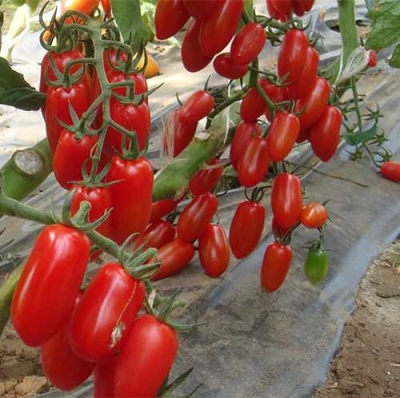
- Authors: Lukyanenko A. N., Dubinin S. V., Dubinina I. N. (Agrofirm Sedek LLC)
- Year of approval: 2015
- Category: hybrid
- Growth type: indeterminate
- Appointment: fresh consumption, for pickling and canning, for whole-fruit canning
- Ripening period: early
- Ripening time, days: 105-110
- Growing conditions: for film greenhouses, for greenhouses
- Marketability: high
- Transportability: high
When choosing tomato seeds, making a choice in favor of a variety or a hybrid, gardeners are guided by personal preferences. Many are inclined towards varietal crops, considering them more tasty and aromatic. With regard to some representatives, they are perhaps right, but there are hybrids that can be called universal not only in purpose, but also in characteristics.
These include the indeterminate medium-fruited hybrid Emperor (synonym - Emperor F1), created for growing in glazed, film and polycarbonate greenhouses. The Emperor's Berry is used for canning, cooking, slicing, as well as summer and winter salads. The fruits have a high marketable yield and excellent transportability.
Breeding history
The result of breeders A. N. Lukyanenko, S. V. Dubinin, I. I. Dubinina from LLC "Agrofirmy Sedek" was approved for use in 2015.
Description of the variety
Powerful, tall (180-200 cm), medium leafy, dense spreading bushes have a strong root system. The shoots are covered with traditional tomato type foliage, with an equally strong tomato flavor. Dark green leaf plates are elongated, slightly dissected, slightly wrinkled and slightly pubescent.
Hybrid advantages:
- strong immunity;
- good productivity;
- resistance to weather changes;
- excellent transportability and good taste;
- attractive appearance and good keeping quality.
Disadvantages:
- the impossibility of growing in open ground;
- difficulty in choosing fruits for whole-fruit canning.
Yellow flowers are collected in simple inflorescences, forming clusters with 5-6 fruits attached to a strong articulated peduncle.
The main qualities of the fruit
Large (from 90-115 g and more), cylindrical, slightly ribbed fruits are colored bright green at the stage of immaturity. During technical and physiological ripeness, they change color to dark scarlet or carmine red.
Taste characteristics
The juicy, fleshy pulp of a pleasant dessert taste with balanced sugars and acidity is covered with a dense skin that is almost imperceptible during meals. Sugar taste with amazing watermelon flavor and long aftertaste. The section shows numerous seed chambers with a limited number of seeds.
Ripening and fruiting
An amazing variety allows for early harvests. From the time of germination to the first ripe tomatoes, a little more than three months pass, but early planting in a greenhouse significantly brings the fruiting period to early to mid-July.
Yield
The hybrid is famous for its good yield - from one bush harvested from 9.4 kilograms of delicious berries.
The timing of planting seedlings and planting in the ground
Considering that the hybrid is intended for cultivation in greenhouses, sowing of seeds can be carried out at the end of February - the first half of March. Young seedlings are planted in 1.5–2 months in a heated greenhouse. They are transplanted into a greenhouse without heating later, when stable positive temperatures come. The exact timing depends on the region. Ripening time - from 105 to 110 days.

Growing tomato seedlings is an extremely important process, because it largely depends on whether the gardener can harvest at all. All aspects must be taken into account, from seedbed preparation to planting in the ground.
Landing scheme
Tall bushes need space, so you should follow the 70x90 cm scheme, in row spacings - 1-1.5 m.

Growing and care
The seedling method of growing allows you to get a harvest in record time. If the climate of the region allows, the seedlings can be transferred to a permanent place already at the stage of 3-4 true leaves.
The hybrid is especially demanding on the fertility and air permeability of the soil. They begin to prepare the land in the greenhouse in the fall - they bring in manure for digging. In spring, the soil is enriched with organic matter (humus, compost, bird droppings), mineral fertilizers and wood ash are added. If the soil needs to be deoxidized, then bone or dolomite flour, cereal husks are added to loosen heavy loam.
Further care consists in the formation of a bush of 1-2 stems, tying, pinching, watering, weeding, feeding and sanitizing. To obtain an optimal yield, 3-4 brushes are left on each bush. Compliance with the requirements of agricultural technology will allow you to get the first berries in 80–90 days, mass ripening begins a little later.




A plant needs different micronutrients at each stage of growth. All fertilizers can be divided into two groups: mineral and organic. Folk remedies are often used: iodine, yeast, bird droppings, eggshells.
It is important to observe the rate and period of feeding. This also applies to folk remedies and organic fertilizers.
Disease and pest resistance
The tomato has strong immunity, is resistant to TMV, late blight, but preventive treatments with insecticides and fungicides are required.


Resistant to adverse weather conditions
The positive qualities of the hybrid lie in its excellent resistance to weather whims, especially since it is protected by greenhouse walls. Temperature drops, cold snaps and intense heat are not terrible for him.
Growing regions
The Greenhouse Emperor is grown in all regions of Russia. These are the Northern, North-Western, Central, Volgo-Vyatka, TsChO, North Caucasian, Middle Volga, Lower Volga, Ural, West Siberian, East Siberian and Far Eastern regions.

























































































